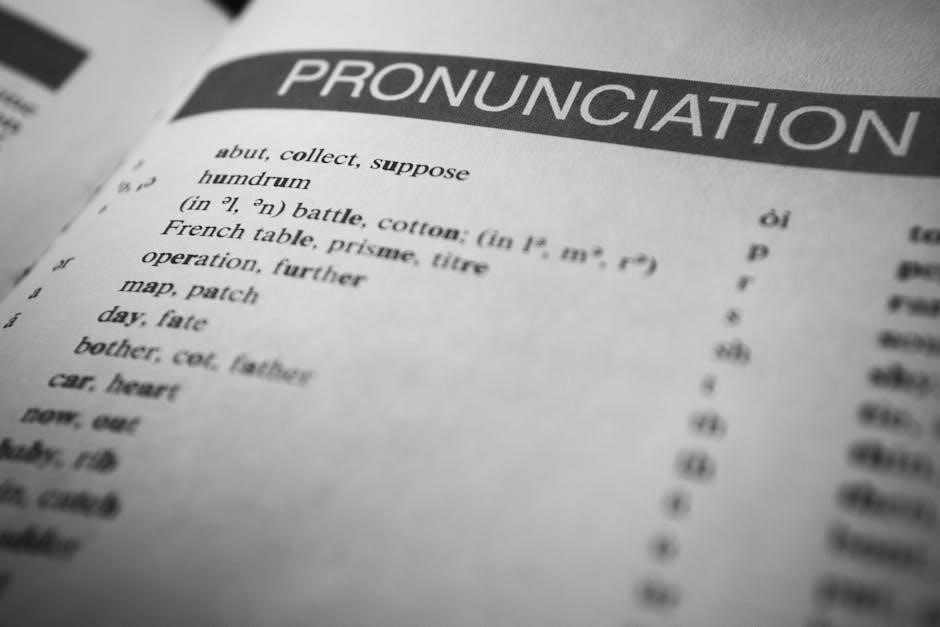The Fundamentals of Instruction provide essential principles for effective teaching, emphasizing communication, assessment, and learning domains. They are crucial for aviation instructors to optimize student learning outcomes and engagement.
1.1 Definition and Importance of Instructional Fundamentals
The Fundamentals of Instruction are core principles guiding effective teaching methods. They emphasize structured lesson planning, clear communication, and assessment techniques to ensure student understanding. These principles, outlined in the FAA-H-8083-9 handbook, are essential for aviation instructors to create engaging and efficient learning environments. By mastering these fundamentals, instructors can address diverse learning needs, promote active participation, and foster meaningful progress in aviation training. Their application ensures consistency and excellence in educational practices across various settings.
1.2 Overview of the FAA Fundamentals of Instruction (FOI)
The FAA Fundamentals of Instruction (FOI) outline essential teaching principles for aviation educators. Covered in the FAA-H-8083-9 handbook, FOI focuses on optimizing the learning experience through effective communication, assessment, and lesson planning. It addresses cognitive, affective, and psychomotor domains, ensuring comprehensive skill development. The FOI is a critical requirement for flight instructors, necessary for both written exams and practical teaching. Mastery of these fundamentals ensures instructors can adapt to student needs, fostering a supportive and effective learning environment. This foundation is vital for achieving educational goals in aviation training.

Domains of Learning
The domains of learning—cognitive, affective, and psychomotor—provide a framework for understanding how students acquire knowledge, develop attitudes, and master skills. This structure guides instructors in creating balanced, comprehensive training programs.
2.1 Cognitive Domain: Knowledge and Understanding
The cognitive domain focuses on the development of knowledge, mental skills, and intellectual abilities. It involves the absorption, processing, and application of information. Instructors should emphasize clear explanations, structured content, and opportunities for students to demonstrate understanding. This domain is foundational, as it builds the knowledge base necessary for decision-making and problem-solving. Effective instruction in this area ensures students can recall facts, comprehend concepts, and apply knowledge in practical situations. It is the cornerstone of learning, enabling progression in other domains like affective and psychomotor.
2.2 Affective Domain: Attitudes and Motivation
The affective domain focuses on attitudes, emotions, and motivations that influence learning. Instructors play a crucial role in shaping students’ perceptions and engagement. Positive reinforcement, encouragement, and creating a supportive environment foster motivation. This domain emphasizes the importance of developing a growth mindset and confidence. By aligning instruction with students’ interests and values, instructors can enhance enthusiasm and commitment to learning. Motivation is a key driver of success, enabling students to persist through challenges and achieve their goals effectively.
2.3 Psychomotor Domain: Skills and Performance
The psychomotor domain focuses on the development of physical skills and the ability to perform tasks effectively. It involves manual dexterity, coordination, and the application of knowledge in practical situations. Instructors should provide clear demonstrations, guided practice, and opportunities for independent execution. Feedback is crucial to refine skills, while patience and encouragement help build confidence. This domain emphasizes hands-on learning, enabling students to master complex procedures and perform them safely and efficiently in real-world scenarios.

Effective Communication Strategies
Effective communication strategies involve clear, concise instruction, active listening, and adaptability to student needs, ensuring understanding and fostering a productive learning environment.
3.1 Verbal and Non-Verbal Communication Techniques
Effective instruction relies on both verbal and non-verbal communication. Verbal techniques include clear enunciation, appropriate tone, and pacing to engage learners. Non-verbal cues, such as body language, eye contact, and gestures, reinforce messages and build rapport. Instructors should align verbal and non-verbal signals to avoid confusion. Awareness of cultural differences in non-verbal communication is also crucial for inclusivity. By mastering these techniques, instructors can convey information accurately, maintain student attention, and create a supportive learning environment.
3.2 Active Listening and Feedback in Instruction
Active listening involves fully engaging with learners to understand their needs and concerns. Instructors should maintain eye contact, nod, and ask clarifying questions to ensure comprehension. Providing timely and constructive feedback is equally important, as it guides improvement and reinforces learning. Feedback should be specific, focused on behavior rather than the individual, and delivered in a supportive manner. This approach fosters a positive learning environment, encourages participation, and helps students build confidence and mastery of the material.
3.3 Clarity and Precision in Instructional Delivery
Clarity and precision are essential for effective instruction, ensuring learners grasp concepts without confusion. Instructors should use simple, clear language, avoiding jargon or overly complex terms. Organizing content logically and providing examples help reinforce understanding. Precision involves delivering accurate, concise information, avoiding ambiguity. Visual aids and demonstrations can enhance clarity, making abstract ideas tangible. By being clear and precise, instructors create an environment where students can focus on learning rather than deciphering unclear instructions, promoting better retention and application of knowledge.

Assessment Techniques in Instruction
Assessment techniques evaluate learner performance, ensuring alignment with instructional objectives. They include formative and summative methods, providing feedback to guide instruction and measure progress effectively.
4.1 Types of Assessments: Formative and Summative
Assessments are categorized into formative and summative evaluations. Formative assessments are ongoing, informal checks used to monitor progress and provide feedback during instruction. They help identify areas needing improvement. Summative assessments, in contrast, are formal evaluations conducted at the end of a lesson or course to measure overall learning. They determine if objectives have been met and are often graded. Both types ensure effective instruction by aligning teaching strategies with learner needs and outcomes, fostering a comprehensive understanding of the material.
4.2 Characteristics of Effective Questions in Assessments
Effective questions in assessments should be clear, specific, and aligned with learning objectives. They must avoid ambiguity and ensure learners understand what is being asked. Questions should be free from bias, ensuring fairness for all participants. Additionally, they should be concise, avoiding unnecessary complexity or jargon. Variety in question types (e.g., multiple-choice, open-ended) caters to different learning styles. Clear instructions and expectations are essential, guiding learners on how to respond. Well-crafted questions enhance the validity and reliability of assessments, ensuring accurate measurement of knowledge and skills.
4.3 Avoiding Biases and Ensuring Objectivity in Assessments
Avoiding biases in assessments is crucial for ensuring fairness and impartiality. Questions should be free from cultural, gender, or racial stereotypes. Language must be neutral and accessible to all learners. Assessments should include diverse perspectives to minimize bias. Clear criteria and rubrics help maintain consistency in grading. Regular review and validation of assessment tools by multiple reviewers can identify and address potential biases. Objectivity is enhanced when assessments focus on measurable outcomes rather than subjective interpretations, ensuring equitable evaluation of all learners’ knowledge and skills.

Responsibilities of an Aviation Instructor
An aviation instructor ensures student understanding, promotes engagement, and creates an inclusive environment. They also assess progress, adapt instruction, and maintain safety standards while fostering professionalism and accountability.
5.1 Creating a Positive and Inclusive Learning Environment
Creating a positive and inclusive learning environment is crucial for effective instruction. Instructors should foster respect, empathy, and equality among all students. This involves encouraging open communication, addressing individual needs, and promoting diversity. A supportive atmosphere helps students feel valued, reducing anxiety and increasing engagement. Instructors should also use inclusive language and adapt teaching methods to accommodate diverse learning styles. By doing so, they create a space where every student can thrive and achieve their full potential.
5.2 Promoting Student Engagement and Participation
Promoting student engagement and participation is essential for effective learning. Instructors should encourage active participation through discussions, group activities, and hands-on exercises. Creating an interactive environment fosters curiosity and motivates students to take an active role in their learning. Encouraging questions, providing opportunities for practice, and incorporating real-world examples can also enhance engagement. Additionally, instructors should acknowledge and reward contributions to build confidence and encourage further participation. This approach ensures students remain focused and invested in the instructional process.
5.3 Recognizing and Addressing Learning Barriers
Recognizing and addressing learning barriers is crucial for ensuring student success. Instructors must identify obstacles such as physical disabilities, language challenges, or emotional difficulties. Observation and assessment are key tools for detecting these barriers. Once identified, instructors can adapt teaching methods to accommodate individual needs. This may include providing additional resources, modifying materials, or using assistive technologies. Addressing these barriers fosters an inclusive environment and ensures all students have equal opportunities to learn and succeed. Timely intervention can significantly improve learning outcomes and student confidence.

Emotional and Psychological Factors in Learning
Emotional and psychological factors significantly influence learning. Motivation, anxiety, and mindset shape a learner’s ability to absorb and process information, affecting engagement and retention.
6.1 Emotional Reactions as Obstacles to Learning
Emotional reactions, such as anxiety, fear, or frustration, can hinder the learning process. These feelings may stem from high-pressure environments, past experiences, or perceived challenges. Instructors must recognize these barriers and create a supportive atmosphere. Encouraging open communication and fostering positivity can help mitigate negative emotions. Understanding the emotional state of learners allows instructors to adapt their teaching strategies, ensuring students feel comfortable and motivated to engage with the material effectively.
6.2 Understanding Stress and Anxiety in the Learning Process
Stress and anxiety are common barriers in learning, often arising from fear of failure or high expectations. These emotions can impair cognitive function, reducing focus and retention. Instructors should identify signs of stress, such as withdrawal or decreased participation. Techniques like mindfulness, relaxation exercises, and positive reinforcement can help alleviate anxiety. Creating a supportive environment fosters confidence, enabling learners to manage stress effectively and engage more productively with the instructional material.

6.3 The Role of Motivation and Attitude in Learning
Motivation and attitude significantly influence learning outcomes. Intrinsic motivation, driven by personal interest, often leads to deeper engagement and persistence. A positive attitude fosters curiosity and openness to new ideas, while a negative attitude can create resistance. Instructors play a crucial role in nurturing motivation by setting clear goals, providing meaningful feedback, and creating a supportive environment. Recognizing individual differences in motivation and addressing them can enhance learning effectiveness and overall student performance in aviation training.

Lesson Planning and Organization
Effective lesson planning ensures structured delivery, aligns with learning objectives, and maximizes student engagement. Organized content promotes logical progression and efficient use of instructional time.
7.1 The Process of Lesson Planning
Lesson planning involves defining objectives, assessing student needs, selecting methods, and organizing content. It ensures alignment with learning goals and promotes engagement. Instructors outline activities, materials, and timing, adapting to student needs; Clear structure enhances understanding and retention. Effective planning considers diverse learning styles and potential challenges, ensuring a logical progression of topics. Regular evaluation and adjustments refine the process, fostering a dynamic and adaptive learning environment tailored to achieve desired outcomes efficiently.
7.2 Setting Clear and Achievable Learning Objectives
Learning objectives are specific outcomes students should achieve by lesson end. They must be clear and understandable to guide instruction and assessment. Objectives should also be achievable, considering students’ abilities and time. Applying the SMART criteria ensures objectives are Specific, Measurable, Achievable, Relevant, and Time-bound. Clear objectives align instruction with desired outcomes, enhancing focus and effectiveness. They also enable accurate assessment of student performance.
7.3 Organizing Content for Effective Instruction
Organizing content effectively ensures logical flow and enhances student understanding. Instructors should break down material into manageable chunks, sequence topics from simple to complex, and align content with learning objectives. Using a clear structure helps students follow along and retain information. Visual aids, examples, and real-world applications can also make content more engaging. A well-organized lesson promotes active learning and reduces confusion, allowing students to focus on key concepts and instructors to deliver material efficiently;

The Role of the Aviation Instructor’s Handbook
The Aviation Instructor’s Handbook serves as a foundational resource for instructors, providing guidance on effective teaching methods, learning principles, and best practices in aviation education. It bridges theory and practical application, ensuring instructors are well-equipped to train safe and competent pilots. The handbook emphasizes clear communication, lesson organization, and assessment techniques, making it indispensable for developing instructional skills and maintaining high educational standards in aviation training environments.
8.1 Overview of the FAA-H-8083-9 Handbook
The FAA-H-8083-9 Handbook is the official guide for aviation instructors, outlining principles of learning, teaching methodologies, and effective instructional techniques. It covers topics such as communication strategies, lesson planning, and assessment methods to ensure comprehensive training. The handbook is designed to help instructors create engaging and structured learning experiences, aligning with FAA standards. It serves as a valuable resource for both new and experienced instructors, promoting consistency and excellence in aviation education by addressing the fundamentals of instruction and practical application.
8.2 Key Topics Covered in the Handbook
The FAA-H-8083-9 Handbook delves into essential topics such as the principles of learning, instructional methods, and the roles of instructors. It explores lesson planning, classroom management, and effective communication techniques. Additionally, it covers assessment strategies, feedback mechanisms, and the integration of technology in training. The handbook also emphasizes the importance of creating a positive learning environment and addressing individual student needs. These topics collectively provide instructors with a comprehensive framework to deliver effective aviation training and ensure student success.
8.3 Integrating the Handbook into Instructional Practices
Effective integration of the FAA-H-8083-9 Handbook involves applying its principles to daily instructional activities. Instructors should use the handbook as a reference for designing engaging lessons and assessing student progress. By aligning teaching methods with the handbook’s guidelines, instructors can ensure consistency and quality in aviation training. Regular review and application of the handbook’s content help instructors refine their techniques, fostering a more effective and learner-centered environment. This integration enhances both instructor competence and student outcomes, making the handbook an indispensable tool for modern aviation education.

Test Preparation Strategies
Effective test preparation involves creating study schedules, engaging in active learning, and reviewing instructional materials. Practice exams and study guides help reinforce key concepts and improve readiness.
9.1 Preparing for the FOI Written Exam
Preparing for the FOI written exam requires a structured approach. Review the FAA-H-8083-9 handbook thoroughly, focusing on key concepts like instructional techniques, lesson planning, and communication strategies. Practice exams help identify weak areas and improve familiarity with the format. Organize study sessions to cover all topics systematically. Use active learning methods, such as self-quizzing and note-taking, to reinforce understanding. Ensure a quiet study environment and manage stress to stay focused. Adequate rest and confidence-building exercises are also essential for optimal performance.
9.2 Using Practice Questions as a Study Guide
Practice questions are an invaluable tool for exam preparation. They help identify gaps in knowledge and familiarize you with the exam format. Regularly tackling practice tests improves time management and reduces anxiety. Reviewing correct answers enhances understanding, while analyzing mistakes clarifies key concepts. Use practice questions to reinforce weak areas and build confidence. Ensure questions align with the FAA-H-8083-9 handbook to focus on relevant material. This method ensures a targeted approach, optimizing study time and effectiveness. Consistent practice leads to better retention and improved performance on the actual exam.
9.3 The Importance of the Instructor’s Handbook in Test Preparation
The Instructor’s Handbook (FAA-H-8083-9) is a critical resource for test preparation. It provides comprehensive coverage of all topics covered on the FOI exam, ensuring alignment with FAA standards. The handbook offers detailed explanations, practical examples, and foundational concepts necessary for success. By studying the handbook, instructors can identify key areas of focus, such as instructional methods and assessment techniques. Regular review of the handbook helps build familiarity with the material, reinforcing understanding and confidence. It is an essential tool for achieving exam readiness and mastery of instructional principles.
